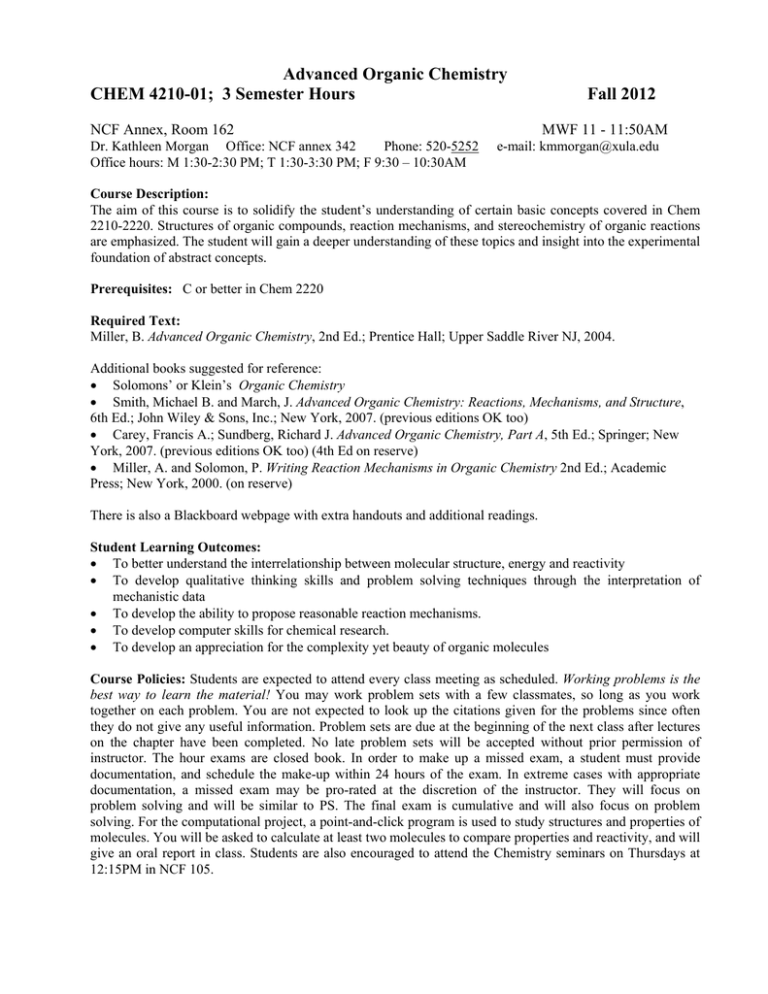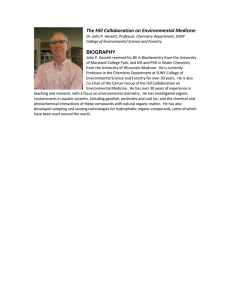Advanced Organic Chemistry CHEM 4210-01;
advertisement

Advanced Organic Chemistry CHEM 4210-01; 3 Semester Hours NCF Annex, Room 162 Dr. Kathleen Morgan Office: NCF annex 342 Phone: 520-5252 Office hours: M 1:30-2:30 PM; T 1:30-3:30 PM; F 9:30 – 10:30AM Fall 2012 MWF 11 - 11:50AM e-mail: kmmorgan@xula.edu Course Description: The aim of this course is to solidify the student’s understanding of certain basic concepts covered in Chem 2210-2220. Structures of organic compounds, reaction mechanisms, and stereochemistry of organic reactions are emphasized. The student will gain a deeper understanding of these topics and insight into the experimental foundation of abstract concepts. Prerequisites: C or better in Chem 2220 Required Text: Miller, B. Advanced Organic Chemistry, 2nd Ed.; Prentice Hall; Upper Saddle River NJ, 2004. Additional books suggested for reference: Solomons’ or Klein’s Organic Chemistry Smith, Michael B. and March, J. Advanced Organic Chemistry: Reactions, Mechanisms, and Structure, 6th Ed.; John Wiley & Sons, Inc.; New York, 2007. (previous editions OK too) Carey, Francis A.; Sundberg, Richard J. Advanced Organic Chemistry, Part A, 5th Ed.; Springer; New York, 2007. (previous editions OK too) (4th Ed on reserve) Miller, A. and Solomon, P. Writing Reaction Mechanisms in Organic Chemistry 2nd Ed.; Academic Press; New York, 2000. (on reserve) There is also a Blackboard webpage with extra handouts and additional readings. Student Learning Outcomes: To better understand the interrelationship between molecular structure, energy and reactivity To develop qualitative thinking skills and problem solving techniques through the interpretation of mechanistic data To develop the ability to propose reasonable reaction mechanisms. To develop computer skills for chemical research. To develop an appreciation for the complexity yet beauty of organic molecules Course Policies: Students are expected to attend every class meeting as scheduled. Working problems is the best way to learn the material! You may work problem sets with a few classmates, so long as you work together on each problem. You are not expected to look up the citations given for the problems since often they do not give any useful information. Problem sets are due at the beginning of the next class after lectures on the chapter have been completed. No late problem sets will be accepted without prior permission of instructor. The hour exams are closed book. In order to make up a missed exam, a student must provide documentation, and schedule the make-up within 24 hours of the exam. In extreme cases with appropriate documentation, a missed exam may be pro-rated at the discretion of the instructor. They will focus on problem solving and will be similar to PS. The final exam is cumulative and will also focus on problem solving. For the computational project, a point-and-click program is used to study structures and properties of molecules. You will be asked to calculate at least two molecules to compare properties and reactivity, and will give an oral report in class. Students are also encouraged to attend the Chemistry seminars on Thursdays at 12:15PM in NCF 105. Course Assignments and Evaluation: Problem sets Hour exams Computational project Final exam 9 x 10 pts 3 x 100 pts 1 x 25 pts, plus up to 5 pts XC 100 pts Total Possible = 515 points The method of assigning letter grades will not be more stringent than the following: A, 90% and above; B, 80-89%; C, 70-79%; D, 60-69%; and F, below 60%. The following is quoted from the Xavier University Faculty Handbook: “If a student's test, examination paper, laboratory report, term paper, or other written assignment gives evidence of not being completely his/her own work, he/she may be given an F for the course. A student who communicates with anyone during the course of an examination or test, unless with the permission of the instructor, may be immediately dismissed from the room and given an F. Such communication includes attempt to read from another's paper. If a student is found to have brought study materials into the examination room without the instructor's permission, it may be assumed that he/she intended to use such materials unlawfully, and he/she may be penalized accordingly.” In addition, students are directed to this Academic Integrity policy: http://www.xula.edu/cas/documents/cas_academicIntegrity.pdf In the event of evacuation students will be informed of class expectations via the Blackboard website. It is the student’s responsibility to check this website and his/her Xavier e-mail account for information. REVISED Schedule: Chapter 1. Introduction; Strain and Reactivity (5-6 classes) Chapter 2. Electrocyclic Reactions (5 classes) First Hour Exam, Chapters 1 and 2, Friday October 5 Chapter 3. Cycloaddition and Cycloreversion Reactions (3-4 classes) Chapter 4. Sigmatropic Reactions (3 classes) Chapter 5. Linear Free-Energy Relationships; Solvent Effects (1-2 classes) Chapter 6. Migrations to Electron-Deficient Centers (3 classes) Second Hour Exam, Chapters 3-6, Wednesday October 31 Chapter 7. Neighboring Group Effects and “Nonclassical” Cations (3 classes) Chapter 8. Rearrangements of Carbanions and Free Radicals (3 classes) Chapter 9. Carbenes, Carbenoids, and Nitrenes (2-3 classes) Third Hour Exam, Chapters 7-9, Monday November 26 Chapter 10. Photochemistry (1-2 classes) Chapters 11-12. Heterocycles (2-3 classes) Synthesis and Natural Products Chemistry (1-2 classes) Oral reports (2 classes) Final exam: Tuesday, December 11, 8:00AM




